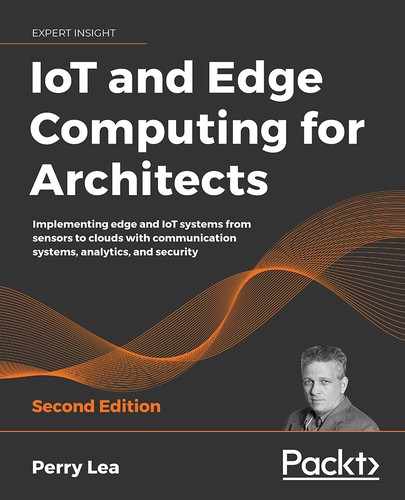Book Description
Learn to design, implement, and secure your IoT infrastructure. Revised and expanded for edge computing.
Key Features
- Build a complete IoT system that's the best fit for your organization
- Learn about different concepts, tech, and trade-offs in the IoT architectural stack
- Understand the theory and implementation of each element that comprises IoT design
Book Description
Industries are embracing IoT technologies to improve operational expenses, product life, and people's well-being. An architectural guide is needed if you want to traverse the spectrum of technologies needed to build a successful IoT system, whether that's a single device or millions of IoT devices.
IoT and Edge Computing for Architects, Second Edition encompasses the entire spectrum of IoT solutions, from IoT sensors to the cloud. It examines modern sensor systems, focusing on their power and functionality. It also looks at communication theory, paying close attention to near-range PAN, including the new Bluetooth® 5.0 specification and mesh networks. Then, the book explores IP-based communication in LAN and WAN, including 802.11ah, 5G LTE cellular, Sigfox, and LoRaWAN. It also explains edge computing, routing and gateways, and their role in fog computing, as well as the messaging protocols of MQTT 5.0 and CoAP.
With the data now in internet form, you'll get an understanding of cloud and fog architectures, including the OpenFog standards. The book wraps up the analytics portion with the application of statistical analysis, complex event processing, and deep learning models. The book then concludes by providing a holistic view of IoT security, cryptography, and shell security in addition to software-defined perimeters and blockchains.
What you will learn
- Understand the role and scope of architecting a successful IoT deployment
- Scan the landscape of IoT technologies, from sensors to the cloud and more
- See the trade-offs in choices of protocols and communications in IoT deployments
- Become familiar with the terminology needed to work in the IoT space
- Broaden your skills in the multiple engineering domains necessary for the IoT architect
- Implement best practices to ensure reliability, scalability, and security in your IoT infrastructure
Who this book is for
This book is for architects, system designers, technologists, and technology managers who want to understand the IoT ecosphere, technologies, and trade-offs, and develop a 50,000-foot view of IoT architecture. An understanding of the architectural side of IoT is necessary.
Table of Contents
- Preface
- IoT and Edge Computing Definition and Use Cases
- IoT Architecture and Core IoT Modules
- Sensors, Endpoints, and Power Systems
- Communications and Information Theory
- Non-IP Based WPAN
- 802.15 standards
- Bluetooth
- IEEE 802.15.4
- Zigbee
- Z-Wave
- Summary
- IP-Based WPAN and WLAN
- TCP/IP
- WPAN with IP – 6LoWPAN
- IEEE 802.11 protocols and WLAN
- IEEE 802.11 suite of protocols and comparison
- IEEE 802.11 architecture
- IEEE 802.11 spectrum allocation
- IEEE 802.11 modulation and encoding techniques
- IEEE 802.11 MIMO
- IEEE 802.11 packet structure
- IEEE 802.11 operation
- IEEE 802.11 security
- IEEE 802.11ac
- IEEE 802.11p vehicle-to-vehicle
- IEEE 802.11ah
- 6LoWPAN topologies
- 6LoWPAN protocol stack
- Mesh addressing and routing
- Header compression and fragmentation
- Neighbor discovery
- 6LoWPAN security
- WPAN with IP – Thread
- Summary
- Long-Range Communication Systems and Protocols (WAN)
- Cellular connectivity
- Governance models and standards
- Cellular access technologies
- 3GPP user equipment categories
- 4G LTE spectrum allocation and bands
- 4G LTE topology and architecture
- 4G LTE E-UTRAN protocol stack
- 4G LTE geographical areas, dataflow, and handover procedures
- 4G LTE packet structure
- Cat-0, Cat-1, Cat-M1, and NB-IoT
- Multefire, CBRS, and shared spectrum cellular
- 5G
- LoRa and LoRaWAN
- Sigfox
- Summary
- Cellular connectivity
- Edge Computing
- Edge purpose and definition
- Edge use cases
- Edge hardware architectures
- Operating systems
- Edge platforms
- Use cases for edge computing
- Summary
- Edge Routing and Networking
- Edge to Cloud Protocols
- Cloud and Fog Topologies
- Cloud services model
- Public, private, and hybrid cloud
- The OpenStack cloud architecture
- Constraints of cloud architectures for IoT
- Fog computing
- Summary
- Data Analytics and Machine Learning in the Cloud and Edge
- Basic data analytics in IoT
- Machine learning in IoT
- IoT data analytics and machine learning comparison and assessment
- Summary
- IoT and Edge Security
- Consortiums and Communities
- Other Books You May Enjoy
- Index
